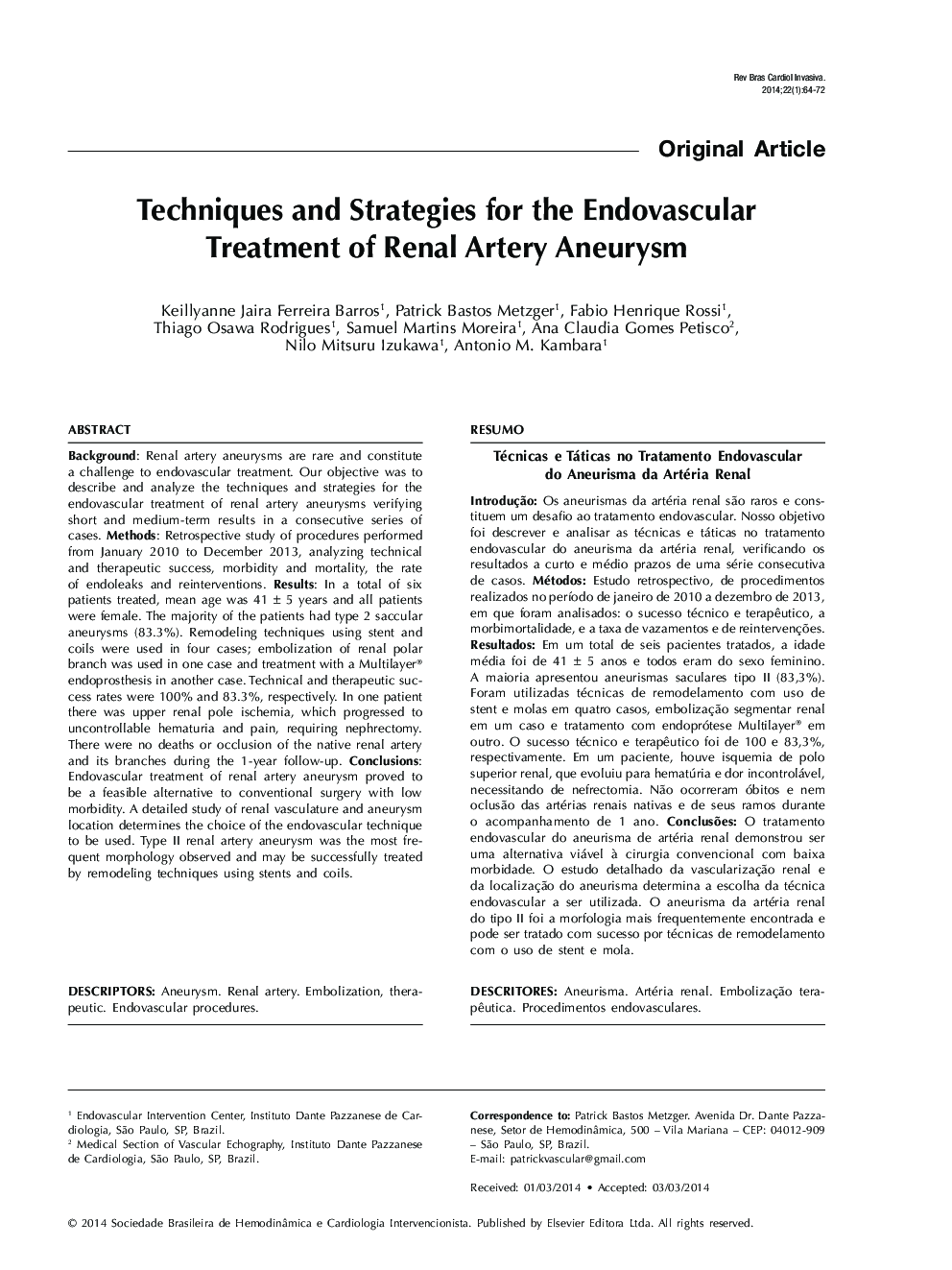| Article ID | Journal | Published Year | Pages | File Type |
|---|---|---|---|---|
| 3011697 | Revista Brasileira de Cardiologia Invasiva (English Edition) | 2014 | 9 Pages |
ABSTRACTBackgroundRenal artery aneurysms are rare and constitute a challenge to endovascular treatment. Our objective was to describe and analyze the techniques and strategies for the endovascular treatment of renal artery aneurysms verifying short and medium-term results in a consecutive series of cases.MethodsRetrospective study of procedures performed from January 2010 to December 2013, analyzing technical and therapeutic success, morbidity and mortality, the rate of endoleaks and reinterventions.ResultsIn a total of six patients treated, mean age was 41 ± 5 years and all patients were female. The majority of the patients had type 2 saccular aneurysms (83.3%). Remodeling techniques using stent and coils were used in four cases; embolization of renal polar branch was used in one case and treatment with a Multilayer® endoprosthesis in another case. Technical and therapeutic success rates were 100% and 83.3%, respectively. In one patient there was upper renal pole ischemia, which progressed to uncontrollable hematuria and pain, requiring nephrectomy. There were no deaths or occlusion of the native renal artery and its branches during the 1-year follow-up.ConclusionsEndovascular treatment of renal artery aneurysm proved to be a feasible alternative to conventional surgery with low morbidity. A detailed study of renal vasculature and aneurysm location determines the choice of the endovascular technique to be used. Type II renal artery aneurysm was the most frequent morphology observed and may be successfully treated by remodeling techniques using stents and coils.
RESUMOTécnicas e Táticas no Tratamento Endovasculardo Aneurisma da Artéria RenalIntroduçãoOs aneurismas da artéria renal são raros e constituem um desafio ao tratamento endovascular. Nosso objetivo foi descrever e analisar as técnicas e táticas no tratamento endovascular do aneurisma da artéria renal, verificando os resultados a curto e médio prazos de uma série consecutiva de casos.MétodosEstudo retrospectivo, de procedimentos realizados no período de janeiro de 2010 a dezembro de 2013, em que foram analisados: o sucesso técnico e terapêutico, a morbimortalidade, e a taxa de vazamentos e de reintervenções.ResultadosEm um total de seis pacientes tratados, a idade média foi de 41 ± 5 anos e todos eram do sexo feminino. A maioria apresentou aneurismas saculares tipo II (83,3%). Foram utilizadas técnicas de remodelamento com uso de stent e molas em quatro casos, embolização segmentar renal em um caso e tratamento com endoprótese Multilayer® em outro. O sucesso técnico e terapêutico foi de 100 e 83,3%, respectivamente. Em um paciente, houve isquemia de polo superior renal, que evoluiu para hematúria e dor incontrolável, necessitando de nefrectomia. Não ocorreram óbitos e nem oclusão das artérias renais nativas e de seus ramos durante o acompanhamento de 1 ano.ConclusõesO tratamento endovascular do aneurisma de artéria renal demonstrou ser uma alternativa viável à cirurgia convencional com baixa morbidade. O estudo detalhado da vascularização renal e da localização do aneurisma determina a escolha da técnica endovascular a ser utilizada. O aneurisma da artéria renal do tipo II foi a morfologia mais frequentemente encontrada e pode ser tratado com sucesso por técnicas de remodelamento com o uso de stent e mola.
